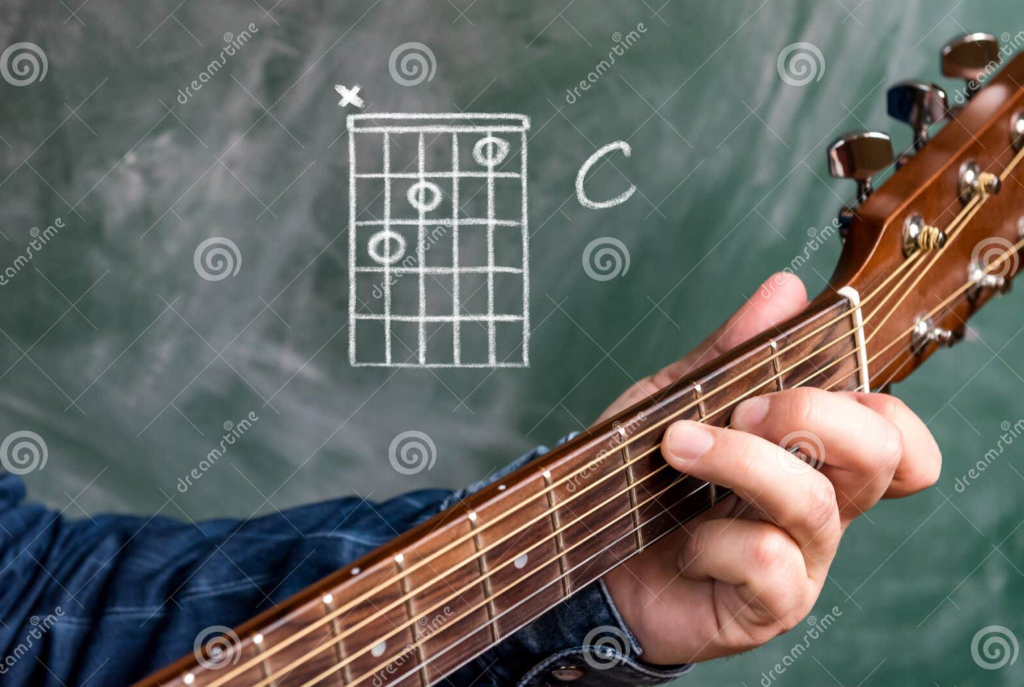The C chord. It might seem simple, but for many beginners, it’s the first major hurdle on their guitar journey. Don’t worry, fret-venturesome friend! This guide will equip you with the knowledge and tips to nail the C chord and unlock a world of musical possibilities.

Why the C Chord Matters:
Think of the C chord as the king of chords. It’s used in countless songs across genres, from pop and rock to blues and country. Mastering it opens doors to playing countless favorites and jamming with friends.
Breaking it Down:
The C chord uses three fingers:
- Index finger: First fret of the B string (second string from the bottom).
- Middle finger: Second fret of the D string (fourth string).
- Ring finger: Third fret of the A string (fifth string).
Strumming:
Once your fingers are in place, strum across the top five strings (excluding the thickest E string). Aim for a clear, ringing sound.
Common Challenges:
- Finger stretch: The ring finger reach can be tricky. Relax your hand and arch your fingers, using the fingertips for precise contact.
- Muting strings: Ensure your fingers aren’t accidentally muting other strings. Keep them close together and perpendicular to the frets.
- Clarity: Strum with control and aim for a clean, full sound. Avoid hitting muted strings or strumming too hard.
Practice Makes Progress:
Start slow and focus on finger placement and clean sound. Gradually increase speed and practice switching between chords. Remember, patience and persistence are key!
Bonus Tips:
- Use a capo: If the stretch is too much, try using a capo on the second fret. This lowers the pitch and makes the chord easier to play.
- Start with one finger: For an easier alternative, try the “C one-finger wonder” version. Place your first finger on the first fret of the B string and strum the top three strings.
- Visualize: Search online for pictures or diagrams of the C chord hand position. Seeing it can help solidify the muscle memory.
- Seek help: Don’t hesitate to ask a guitar teacher or friend for guidance. A little personalized instruction can go a long way.
Remember, conquering the C chord is a significant achievement. Celebrate your progress, keep practicing, and soon you’ll be strumming your way to musical mastery!
Mastering the F Chord: Your Gateway to Barre Chords on Guitar
The F chord might be one of the first major roadblocks for beginner guitarists, but fret not! With the right approach and practice, you’ll be strumming this essential chord in no time. Here’s your guide to conquering the F chord:
Why the F Chord Matters:
The F chord is a fundamental building block in many genres, from folk and rock to pop and blues. It unlocks countless songs and opens doors to more complex barre chords down the line. So buckle up, because mastering this chord is a significant step in your guitar journey!
Understanding the Barre Chord Shape:
The F chord is a barre chord, meaning one finger (usually the index) presses down on multiple strings across the fretboard. In the case of the F chord, your index finger acts as a “mini capo,” barring the first fret across the top five strings (excluding the thickest E string). Here’s the finger placement for the complete F chord:
- Index finger: Barre across the first fret (top five strings)
- Middle finger: Third fret of the D string (fourth string)
- Ring finger: Second fret of the G string (third string)
- Pinky finger: Third fret of the B string (second string)
Common Challenges and Tips:
- Finger strength and stretch: Barre chords require finger strength and flexibility, especially for the barring finger. Start slow, practice regularly, and don’t get discouraged if it takes time. You can also warm up your fingers with stretches before playing.
- Clarity and muting: Ensure your barring finger presses down firmly and cleanly across all five strings without muting them. Practice muting only the intended strings with your other fingers.
- Strumming: Strum with control, focusing on clean sounds and avoiding hitting muted strings. Experiment with different strumming patterns once you’re comfortable with the chord shape.
Practice, Patience, and Progress:
Remember, mastering any chord takes time and dedication. Be patient, practice consistently, and focus on proper technique. Start slow, gradually increase speed, and incorporate chord changes into your practice routine. Celebrate your progress, and don’t hesitate to seek help from a guitar teacher or online resources if needed.
Alternative Fingerings:
While the full barre chord is the ultimate goal, there are easier variations for beginners. Here are two popular options:
- Open F Chord: This version omits the barre and uses only three fingers:
- Index finger: First fret of the B string (second string)
- Middle finger: Second fret of the G string (third string)
- Ring finger: Third fret of the D string (fourth string)
F Chord (without the E string): This variation avoids the high E string, making it easier to barre:
- Index finger: Barre across the first fret (D, G, B strings)
- Middle finger: Third fret of the D string (fourth string)
- Ring finger: Second fret of the G string (third string)
- Pinky finger: Third fret of the B string (second string)